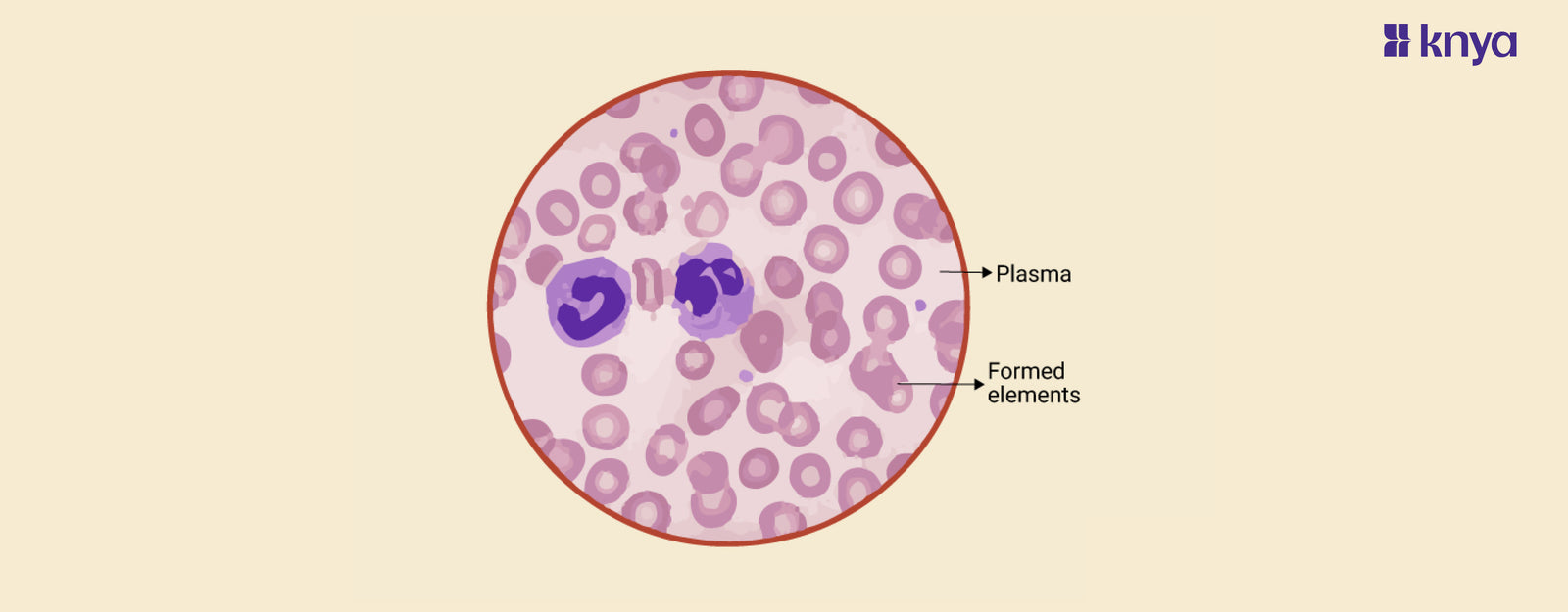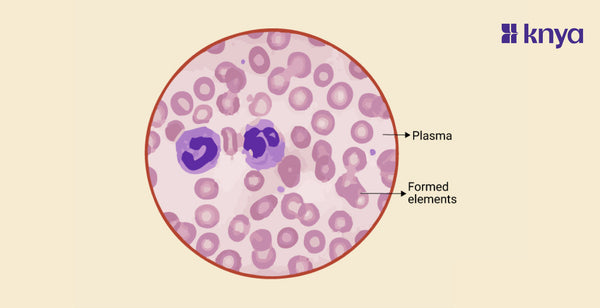Difference Between Blood Plasma and Lymph: Blood plasma and lymph are two crucial components of the circulatory system, each playing distinct roles in maintaining the body's physiological balance. While both are fluids circulating within the body, they differ significantly in composition, functions, and locations. Understanding the disparities between blood plasma and lymph is essential for grasping the intricate workings of the circulatory and immune systems. Let's explore the key differences through the following bullet points:
Difference Between Blood Plasma and Lymph
Here's a side-by-side comparison of the differences between blood plasma and lymph presented in a table:
|
Characteristic |
Blood Plasma |
Lymph |
|
Composition |
Water, electrolytes, proteins (clotting factors, antibodies), hormones, waste products |
Water, white blood cells, proteins, fats (in chyle) |
|
Volume in Circulation |
Constitutes about 55% of total blood volume |
Derived from interstitial fluid, forms part of the lymphatic system |
|
Functions |
Nutrient transport, waste removal, maintenance of blood pressure and pH levels |
Immune defense, carrying white blood cells, filtration through lymph nodes |
|
Role in Clotting |
Essential for blood clotting and preventing excessive bleeding |
Not directly involved in clotting, focuses on immune functions |
|
Circulation Location |
Flows within blood vessels - arteries, veins, and capillaries |
Flows within the lymphatic vessels, running parallel to the circulatory system |
|
Origin |
Always in circulation within blood vessels |
Originates as interstitial fluid, transforms into lymph as it's collected by lymphatic vessels |
|
Color |
Yellowish due to the presence of proteins and other components |
Clear to milky white |
|
Transport Medium |
Carries nutrients, hormones, gases, and waste products throughout the body |
Primarily involved in transporting immune cells, fats, and tissue fluid |
|
Pressure |
Maintains blood pressure within blood vessels |
Does not exert pressure, as it moves more slowly through lymphatic vessels |
|
Cellular Elements |
Contains red blood cells, white blood cells, and platelets |
Dominated by white blood cells (lymphocytes and macrophages) |
|
Storage for Nutrients |
Acts as a reservoir for nutrients and electrolytes |
Does not serve as a storage medium for nutrients |
|
Originating Fluid |
Does not transform from another fluid; always present in the bloodstream |
Originates from interstitial fluid that leaks from blood vessels |
|
Contribution to Immunity |
Limited immune components, primarily antibodies involved in defense |
Integral part of the immune system, carrying immune cells for defense |
|
Fluid Movement |
Exhibits rapid movement within the circulatory system |
Flows more slowly through the lymphatic vessels, moving in one direction |
|
Volume Regulation |
Volume is actively regulated by the kidneys and hormones |
Volume is regulated by the lymphatic system, influenced by tissue fluid dynamics |
Shop best Lab Coats Here!
What is Blood Plasma?
Blood plasma is the yellowish, liquid component of blood that makes up approximately 55% of the total blood volume. It serves as a crucial and complex medium in the circulatory system, playing a variety of essential roles. Blood plasma is composed of water, electrolytes, proteins, hormones, and waste products. The key components of blood plasma include:
- Water: The primary component, making up the majority of the plasma, serving as a solvent for various substances.
- Electrolytes: Essential minerals and ions, such as sodium, potassium, calcium, and chloride, which play a role in maintaining the body's balance and electrical conductivity.
- Proteins: Various proteins are present in plasma, including clotting factors (such as fibrinogen), antibodies (for immune defense), and albumin (which helps regulate blood volume and pressure).
- Hormones: Chemical messengers produced by glands that regulate various physiological processes.
- Waste Products: Substances like urea and carbon dioxide, which are byproducts of metabolic processes.
Blood plasma functions as a transport medium, carrying nutrients, gases, hormones, and waste products throughout the body. It plays a crucial role in maintaining blood pressure and pH levels. Additionally, plasma is essential for blood clotting, as it contains proteins necessary for the coagulation process.
The separation of blood through centrifugation results in distinct layers, with blood plasma constituting the liquid portion. It is a vital component for various medical treatments, such as blood transfusions and plasma therapies.
Check out Men's Long Lab Coat Apron
What is Lymph?
Lymph is a colorless and watery fluid that forms part of the lymphatic system, a network of vessels, nodes, and organs that work in conjunction with the circulatory system and the immune system. Lymph is derived from interstitial fluid, which is the fluid that surrounds cells and tissues.
Key Characteristics of Lymph:
- Composition: Lymph is primarily composed of water, white blood cells (mainly lymphocytes), proteins, and occasionally fats (in the case of chyle, a milky fluid formed during the digestion of fats).
- Formation: Lymph is formed when interstitial fluid, the fluid that bathes the cells, is collected by lymphatic vessels. This fluid is then transported through the lymphatic system.
- Function: The primary function of lymph is to support the immune system. Lymphatic vessels carry lymph through lymph nodes, where white blood cells, particularly lymphocytes, filter and purify the lymph by trapping and destroying pathogens (such as bacteria or viruses). Lymph nodes play a crucial role in immune defense.
- Transport: Lymphatic vessels transport lymph throughout the body, eventually returning it to the bloodstream. Unlike blood, lymph does not circulate in a closed system with a pump (like the heart). Instead, lymphatic vessels rely on muscle contractions and body movements to propel lymph.
- Origination: Lymph originates from interstitial fluid that leaks from blood vessels into the surrounding tissues. This fluid, which carries oxygen and nutrients to cells, eventually becomes lymph as it enters the lymphatic vessels.
- Clear Appearance: Lymph is usually clear or slightly yellow in appearance, distinguishing it from blood.
- Lymphatic System: The lymphatic system is a vital part of the body's immune defense, as it helps remove toxins, waste products, and pathogens from tissues and plays a crucial role in maintaining fluid balance.
The movement of lymph is essential for immune function and maintaining tissue fluid balance. The lymphatic system acts as a drainage system, returning excess interstitial fluid to the bloodstream and aiding in the body's defense against infections.
Similarity Between Blood Plasma and Lymph
Blood plasma and lymph are both fluids that play essential roles in maintaining the body's overall function. Despite their differences, there are some similarities between blood plasma and lymph:
- Fluid Composition: Both blood plasma and lymph contain water as a primary component. Water serves as a solvent for various substances and facilitates the transport of nutrients, gases, and waste products.
- Protein Content: Both fluids contain proteins. In blood plasma, proteins include clotting factors, antibodies, and albumin, while lymph contains various proteins, particularly antibodies and enzymes.
- Transport Medium: Both serve as transport mediums within the body. Blood plasma carries oxygen, nutrients, hormones, and waste products through the circulatory system, while lymph transports white blood cells, proteins, and tissue fluid through the lymphatic system.
- Derived from Interstitial Fluid: Lymph is derived from interstitial fluid, the fluid that bathes cells and tissues. This interstitial fluid leaks from blood vessels and is then collected by lymphatic vessels. Blood plasma, while not directly derived from interstitial fluid, contributes to its formation through the exchange of substances with tissues.
- Influence on Immune System: Both fluids play roles in the immune system. Blood plasma contains antibodies and immune proteins that contribute to the body's defense against infections, while lymph, rich in white blood cells, particularly lymphocytes, is a crucial component of the immune response.
- Fluid Movement: Both blood plasma and lymph move through vessels within the body. Blood plasma circulates within the blood vessels (arteries, veins, and capillaries) powered by the pumping action of the heart. Lymph, on the other hand, moves through the lymphatic vessels, relying on muscle contractions and body movements for propulsion.
While blood plasma and lymph have distinct functions and locations within the body, their similarities in composition and immune system involvement highlight their interconnected roles in maintaining homeostasis and supporting the body's defense mechanisms.
|
Check out More Articles |
|















